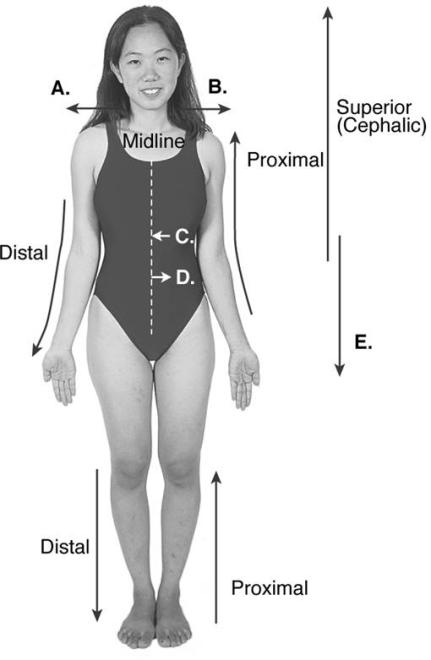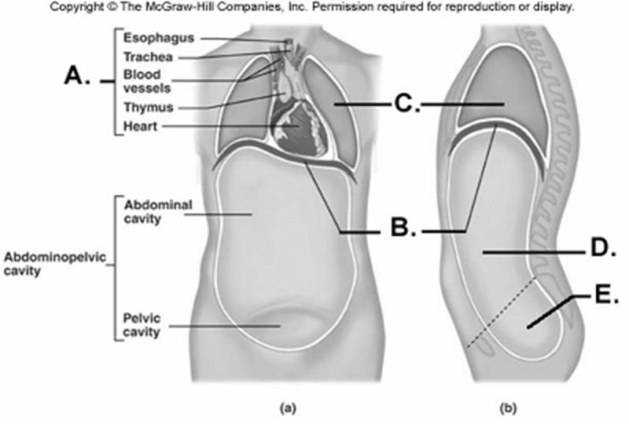A) diaphragm
B) mediastinum
C) pelvic cavity
D) thoracic cavity
E) abdominal cavity
G) C) and D)
Correct Answer

verified
Correct Answer
verified
Multiple Choice
The suffix "-itis" means inflammation. Which of the following terms means inflammation of the membrane lining the body cavity that contains the liver?
A) pericarditis
B) peritonitis
C) pleurisy
D) colitis
E) hepatitis
G) A) and B)
Correct Answer

verified
Correct Answer
verified
Multiple Choice
Which of the following sets of directional terms are most appropriately referred to as opposites?
A) distal and proximal
B) medial and inferior
C) superior and ventral
D) anterior and deep
E) lateral and superior
G) B) and E)
Correct Answer

verified
Correct Answer
verified
Multiple Choice
Proximal means
A) toward the middle or midline of the body.
B) away from the surface.
C) closer to the head.
D) closer than another structure to the point of attachment to the trunk.
E) toward the back of the body.
G) A) and B)
Correct Answer

verified
Correct Answer
verified
Multiple Choice
Nerve cells generate electrical signals in response to changes in the environment. This is an example of
A) respiration.
B) digestion.
C) movement.
D) filtration.
E) responsiveness.
G) A) and E)
Correct Answer

verified
Correct Answer
verified
Multiple Choice
Which of the following describes the position of the nose?
A) inferior to the chin
B) superior to the forehead
C) posterior to the ears
D) lateral to the eyes
E) superior to the mouth
G) C) and E)
Correct Answer

verified
Correct Answer
verified
Multiple Choice
Which of the following is NOT the correct name of an organ system?
A) integumentary
B) lymphatic
C) cardiovascular
D) muscular
E) hormonal
G) B) and E)
Correct Answer

verified
Correct Answer
verified
Multiple Choice
Anatomy is
A) the study of function.
B) a branch of physiology.
C) the study of structure.
D) the study of living organisms.
E) the study of homeostasis.
G) A) and B)
Correct Answer

verified
Correct Answer
verified
Multiple Choice
The study of tissues is
A) cytology.
B) histology.
C) molecular biology.
D) microbiology.
E) surface anatomy.
G) A) and C)
Correct Answer

verified
Correct Answer
verified
Multiple Choice
Microscopic examination of a frozen tissue specimen is an application of which of the following disciplines?
A) histology
B) physiology
C) gross anatomy
D) radiology
E) regional anatomy
G) C) and D)
Correct Answer

verified
Correct Answer
verified
Multiple Choice
The pectoral region is the
A) area in front of the elbow.
B) chest area.
C) lower back.
D) bottom of foot.
E) forearm.
G) A) and D)
Correct Answer

verified
Correct Answer
verified
Multiple Choice
 -Directional terms are important in the study of anatomy. What does "B" represent?
-Directional terms are important in the study of anatomy. What does "B" represent?
A) median
B) right
C) left
D) inferior
E) lateral
G) C) and D)
Correct Answer

verified
Correct Answer
verified
Multiple Choice
An organism's ability to use energy in order to swim is an example of
A) metabolism.
B) responsiveness.
C) organization.
D) maturation.
E) development.
G) D) and E)
Correct Answer

verified
Correct Answer
verified
Multiple Choice
A vertical plane that separates the body into right and left portions is called a _____ plane.
A) sagittal
B) transverse
C) frontal
D) horizontal
E) coronal
G) B) and E)
Correct Answer

verified
Correct Answer
verified
Multiple Choice
 -Here is a figure showing major trunk cavities and other structures. What does "E" represent?
-Here is a figure showing major trunk cavities and other structures. What does "E" represent?
A) diaphragm
B) mediastinum
C) pelvic cavity
D) thoracic cavity
E) abdominal cavity
G) B) and D)
Correct Answer

verified
Correct Answer
verified
Multiple Choice
Magnetic resonance imaging is based on the movement of
A) electrons in a magnetic field.
B) carbons in a magnetic field.
C) protons in a magnetic field.
D) cells in a magnetic field.
F) C) and D)
Correct Answer

verified
Correct Answer
verified
Multiple Choice
The parietal pericardium is
A) a double-layered serous membrane that anchors some of the abdominal organs to the body wall.
B) the serous membrane that covers the lungs.
C) the serous membrane that lines the abdominal and pelvic cavities.
D) space located between the visceral and parietal pleura.
E) the membrane that lines the pericardial sac.
G) B) and C)
Correct Answer

verified
Correct Answer
verified
Multiple Choice
The anatomical term that means "away from the midline of the body" is
A) medial.
B) proximal.
C) distal.
D) lateral.
E) superficial.
G) B) and C)
Correct Answer

verified
Correct Answer
verified
Multiple Choice
What plane divides the body into equal right and left halves?
A) coronal
B) transverse
C) median
D) sagittal
E) frontal
G) C) and D)
Correct Answer

verified
Correct Answer
verified
Multiple Choice
The antecubital region is the
A) area in front of the elbow.
B) chest area.
C) lower back.
D) bottom of foot.
E) forearm.
G) All of the above
Correct Answer

verified
Correct Answer
verified
Showing 81 - 100 of 111
Related Exams